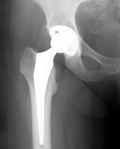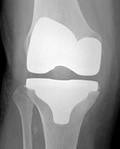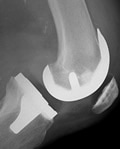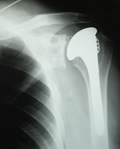|
According to the Journal of Bone and Joint Surgery (JBJS), patients managed at hospitals and by surgeons with greater volume of joint replacements have lower risks of perioperative adverse events following total joint replacement. There is increasing evidence to support the majority of joint replacements can now be performed safely and with excellent outcomes when the surgery is performed in a same days fashion in the outpatient setting.
The Connecticut Joint Replacement Institute, CJRI opened its doors at St. Francis Hospital in August 2007. Drs. Joyce, Dukas and Merrill and partners of the institution. This institute combines the expertise of the leading Joint Replacement Surgeons in Connecticut who combine to do over 2000 Joint Replacement surgeries a year – making CJRI one of the largest joint replacement centers in the country (and the largest in New England). The surgical outcomes have been published and are well below the national averages. Please refer to the CJRI web site for more information and this unique and specialized experience. Since its opening, Lighthouse Surgical Center has been a model for outpatient same day Joint replacement procedure. Similar to CJRI, physician driven standards and protocols help maintain Lighthouse Surgical Center as an award winning destination for outpatient elective joint arthroplasty with superb outcomes. |
|
Hip Replacement Surgery

Hip replacement surgery has experienced a renaissance over the past 5 years. Innovations in small incision and minimally invasive surgery have advanced the procedure so that most patients have a quicker and less painful recovery. Most patients will have a small 4 or 5 inch incision with dissolving sutures (no painful staples).
Improvements in anesthesia have lead to a much better patient experience. At both CJRI and Lighthouse Surgical Center we combine general anesthesia with both pre-operative medications and ultra-sound guided nerve blocks in order to decrease both surgical pain and the pain experienced throughout recovery. Less pain leads to a rapid return of leg function and activities.
The use of newer plastic bearing surfaces or ceramics are responsible for advances in hip replacements. These modern hip replacements have increased mobility and a decreased chance of dislocation, two important factors that have improved patient satisfaction. Most importantly, advances in materials have increased the durability of the implants so it is likely they will last longer.
Minimally invasive hip replacement surgery patients are allowed to place full weight on their operative hip the day following surgery and should be walking in the hallway on the second day following surgery. Nearly all patients are ready for discharge the third day following surgery. Patients are given antibiotics at the time of surgery to decrease the risk of infection and prescribed blood thinners for 10 days following surgery to decrease the risk of blood clots. Ask our providers about the risks and benefits of Hip Replacement surgery.
Improvements in anesthesia have lead to a much better patient experience. At both CJRI and Lighthouse Surgical Center we combine general anesthesia with both pre-operative medications and ultra-sound guided nerve blocks in order to decrease both surgical pain and the pain experienced throughout recovery. Less pain leads to a rapid return of leg function and activities.
The use of newer plastic bearing surfaces or ceramics are responsible for advances in hip replacements. These modern hip replacements have increased mobility and a decreased chance of dislocation, two important factors that have improved patient satisfaction. Most importantly, advances in materials have increased the durability of the implants so it is likely they will last longer.
Minimally invasive hip replacement surgery patients are allowed to place full weight on their operative hip the day following surgery and should be walking in the hallway on the second day following surgery. Nearly all patients are ready for discharge the third day following surgery. Patients are given antibiotics at the time of surgery to decrease the risk of infection and prescribed blood thinners for 10 days following surgery to decrease the risk of blood clots. Ask our providers about the risks and benefits of Hip Replacement surgery.
Knee Replacement Surgery

Minimally invasive knee replacement surgery is an important advancement that has revolutionized the operation. Modern active multimodal recovery techniques help speed patients' recoveries and decrease post operative pain. Most patients will have a small 4 or 5 inch incision with dissolving sutures (no painful staples). By cutting less muscle tissue, patients regain strength and motion quicker and with less pain.
Improvements in anesthesia have lead to a much better patient experience. At both CJRI and Lighthouse Surgical Center we combine general anesthesia with both pre-operative medications and ultra-sound guided nerve blocks in order to decrease both surgical pain and the pain experienced throughout recovery. Less pain leads to a rapid return of leg function and activities.
Minimally invasive knee replacement surgery patients are allowed to place full weight on their operative leg the day following surgery and should be walking in the hallway the second day following surgery. Restoring knee bending is a critical part of your recovery. The day following surgery a CPM (continuous passive motion) device is placed below your leg and mechanically starts the knee bending process while you rest in bed. Each day the CPM bends your knee a little further as you gradually restore knee range of motion. Nearly all patients are ready for discharge the third day following surgery, sent home with a CPM device. Patients are given antibiotics at the time of surgery to decrease the risk of infection and prescribed blood thinners for 10 days following surgery to decrease the risk of blood clots. Ask our providers about the risks and benefits of knee replacement surgery.
Improvements in anesthesia have lead to a much better patient experience. At both CJRI and Lighthouse Surgical Center we combine general anesthesia with both pre-operative medications and ultra-sound guided nerve blocks in order to decrease both surgical pain and the pain experienced throughout recovery. Less pain leads to a rapid return of leg function and activities.
Minimally invasive knee replacement surgery patients are allowed to place full weight on their operative leg the day following surgery and should be walking in the hallway the second day following surgery. Restoring knee bending is a critical part of your recovery. The day following surgery a CPM (continuous passive motion) device is placed below your leg and mechanically starts the knee bending process while you rest in bed. Each day the CPM bends your knee a little further as you gradually restore knee range of motion. Nearly all patients are ready for discharge the third day following surgery, sent home with a CPM device. Patients are given antibiotics at the time of surgery to decrease the risk of infection and prescribed blood thinners for 10 days following surgery to decrease the risk of blood clots. Ask our providers about the risks and benefits of knee replacement surgery.
Partial Knee Replacement Surgery

Partial knee replacement surgery is a specialized procedure for a select group of knee arthritis patients who have worn out a single portion of their knee. Most patients with knee arthritis require a full knee replacement; however for those with limited disease less surgery is probably better. In consultation with one of the Surgeon of Orthopaedic Sports Specialists, the most appropriate treatment option will be customized to your specific knee disease.
Most patients will have a small 3 or 4 inch incision with dissolving sutures (no painful staples). By cutting no muscle tissue, patients get their strength and motion back within a few weeks, almost always quicker than patients undergoing full knee replacement surgery.
Improvements in anesthesia have lead to a much better patient experience. At both CJRI and Lighthouse Surgical Center we combine general anesthesia with both pre-operative medications and ultra-sound guided nerve blocks in order to decrease both surgical pain and the pain experienced throughout recovery. Less pain leads to a rapid return of leg function and activities.
Partial knee replacement surgery patients are allowed to place full weight on their operative leg the day following surgery and should be walking in the hallway the second day following surgery. Restoring knee bending is a critical part of your recovery. The day following surgery a CPM (continuous passive motion) device is placed below your leg and mechanically starts the knee bending process while you rest in bed. Each day the CPM bends your knee a little further as you gradually restore knee range of motion. Nearly all patients are ready for discharge the third day following surgery, sent home with a CPM device. Patients are given antibiotics at the time of surgery to decrease the risk of infection and prescribed blood thinners for 10 days following surgery to decrease the risk of blood clots. Ask our providers about the risks and benefits of partial knee replacement surgery.
Most patients will have a small 3 or 4 inch incision with dissolving sutures (no painful staples). By cutting no muscle tissue, patients get their strength and motion back within a few weeks, almost always quicker than patients undergoing full knee replacement surgery.
Improvements in anesthesia have lead to a much better patient experience. At both CJRI and Lighthouse Surgical Center we combine general anesthesia with both pre-operative medications and ultra-sound guided nerve blocks in order to decrease both surgical pain and the pain experienced throughout recovery. Less pain leads to a rapid return of leg function and activities.
Partial knee replacement surgery patients are allowed to place full weight on their operative leg the day following surgery and should be walking in the hallway the second day following surgery. Restoring knee bending is a critical part of your recovery. The day following surgery a CPM (continuous passive motion) device is placed below your leg and mechanically starts the knee bending process while you rest in bed. Each day the CPM bends your knee a little further as you gradually restore knee range of motion. Nearly all patients are ready for discharge the third day following surgery, sent home with a CPM device. Patients are given antibiotics at the time of surgery to decrease the risk of infection and prescribed blood thinners for 10 days following surgery to decrease the risk of blood clots. Ask our providers about the risks and benefits of partial knee replacement surgery.
Shoulder Replacement Surgery

Shoulders can wear out just like hips and knees do. Most patients tolerate the pain and loss of function with shoulder arthritis better that they do with hip and knee arthritis since the shoulder is not a weight bearing joint. Eventually, the pain and loss of motion may become so serve that shoulder replacement surgery is considered. For many patients it is the onset of night-time pain that leads to the decision for surgery.
There are several different types of shoulder replacement operations to meet the diverse needs of many different types of patients. For younger, high-demand, patients partial shoulder replacement surgery is considered. In cases of severe arthritis a total shoulder replacement is a probable option. Finally, patients with no rotator cuff function in combination with shoulder arthritis a reverse shoulder replacement is the treatment of choice.
While this is a far less common operation that hip and knee replacement, specially training that includes a shoulder fellowship should be considered by patients when they select their surgeon. Improvements in anesthesia have lead to a much better patient experience. At both CJRI and Lighthouse Surgical Center we combine general anesthesia with both pre-operative medications and ultra-sound guided nerve blocks in order to decrease both surgical pain and the pain experienced throughout recovery. Less pain leads to a rapid return of shoulder function and activities.
Following surgery you will be in a padded sling and ready to begin motion exercises with your therapist the day following surgery. Most patients are ready to go home the second day following surgery. Patients are given antibiotics at the time of surgery to decrease the risk of infection and prescribed blood thinners for 10 days following surgery to decrease the risk of blood clots. A minimum of a couple of months of post-operative physical therapy is necessary to restore shoulder motion and strength. Ask our providers about the risks and benefits of Shoulder Replacement surgery.
There are several different types of shoulder replacement operations to meet the diverse needs of many different types of patients. For younger, high-demand, patients partial shoulder replacement surgery is considered. In cases of severe arthritis a total shoulder replacement is a probable option. Finally, patients with no rotator cuff function in combination with shoulder arthritis a reverse shoulder replacement is the treatment of choice.
While this is a far less common operation that hip and knee replacement, specially training that includes a shoulder fellowship should be considered by patients when they select their surgeon. Improvements in anesthesia have lead to a much better patient experience. At both CJRI and Lighthouse Surgical Center we combine general anesthesia with both pre-operative medications and ultra-sound guided nerve blocks in order to decrease both surgical pain and the pain experienced throughout recovery. Less pain leads to a rapid return of shoulder function and activities.
Following surgery you will be in a padded sling and ready to begin motion exercises with your therapist the day following surgery. Most patients are ready to go home the second day following surgery. Patients are given antibiotics at the time of surgery to decrease the risk of infection and prescribed blood thinners for 10 days following surgery to decrease the risk of blood clots. A minimum of a couple of months of post-operative physical therapy is necessary to restore shoulder motion and strength. Ask our providers about the risks and benefits of Shoulder Replacement surgery.


